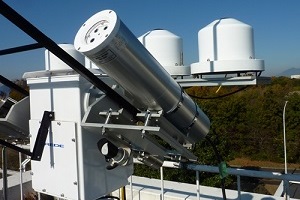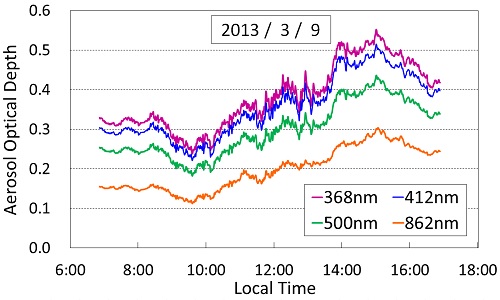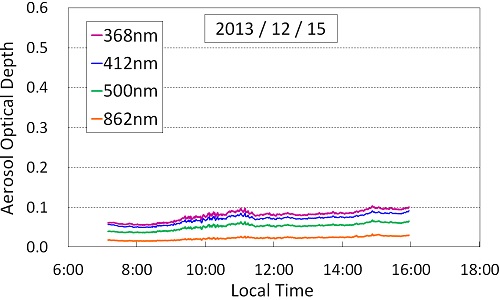Observation of Aerosol Optical Depth
Significance of observation
Aerosols are fine particles floating in the atmosphere. Their many types include particles of natural origin blown up from land/sea surfaces, anthropogenic particles and secondary aerosols formed from anthropogenic and biogenic precursors. In addition to absorbing and scattering sunlight, they also contribute to cloud formation in their role as condensation nuclei and influence the amount of solar radiation reaching the earth. Increased aerosol concentrations are therefore considered to reduce the amount of direct solar radiation reaching the earth and to contribute to climate change.
Principles and theory of measurement
Solar radiation heading toward the earth decays due to scattering and absorption by atmospheric elements such as air molecules, aerosols, water vapor, carbon dioxide and ozone.
Solar irradiance at a specific wavelength of λ is represented by the following equation according to the Lambert-Beer Law:
I(λ) = I0(λ)exp(-m(θ)*τ(λ))
Here,
I(λ): solar irradiance at a wavelength of λ at the earth's surface
I0(λ): extra-terrestrial solar irradiance at a wavelength of λ
τ(λ): atmospheric optical depth when the optical air mass is 1
m(θ): relative air column length of zenith angle θ at that of zenith direction 1 (optical air mass)
τ(λ) is called the optical depth, and is defined as 1 when solar irradiance at the earth's surface is attenuated to be 1 / e (1/2.72) times the extra-terrestrial solar irradiance where the optical air mass is 1.
Alternatively, τ at a certain wavelength can be expressed as follows:
τ = τ(air) + τ(aro) + τ(gas)
Here,
τ(air): optical depth of air molecules
τ(aro): aerosol optical depth(AOD)
τ(gas): optical depth of the absorbing atmosphere element (e.g., water vapor, carbon dioxide, ozone)
Thus, AOD is determined as follows:
τ(aro) = (1/m) * ln(I0 / I) - (τ(air) + τ(gas))
Here, τ(air) is calculated from local pressure and τ(gas) is eliminated by selecting the specific wavelength where there is no radiation absorption by water vapor, carbon dioxide and so on. Additionally, absorption by ozone is calculated using the total ozone amount and its absorption coefficient at the relevant wavelength.
AOD is calculated at wavelengths of 368, 412, 500 and 862 nm as recommended by the World Climate Research Programme (WCRP) in a technical report (WCRP (1986)) in Tsukuba.
Observation instruments
- Filter-type sunphotometer
- This instrument disperses sunlight using an interference filter that allows only a specific wavelength to pass. The sunlight is changed into an electrical signal via a silicon photodiode, amplified via an amplifier for each wavelength, and output as a voltage signal.
- Diffraction-grating-type sunphotometer
- This instrument disperses sunlight using diffraction grating and outputs the solar irradiance of each wavelength as a relative count value using a silicon CCD array.
Observation method
A sunphotometer is mounted on a solar tracker to ensure that sun beams are constantly directed to the instrument throughout the year. Observation data are acquired in one-minute samplings using a filter-type sunphotometer and a diffraction-grating-type sunphotometer.

Filter-type sunphotometer (PFR)
Observation results
Examples of observation results from Tsukuba are shown below. In spring, AOD increases in Tsukuba. Aerosol concentrations are considered to increase as a result of Kosa (Aeolian dust) and air pollutants from the continent (Aeolian Dust (JMA website)). AOD decreases in winter because the atmosphere is clearer. Kosa was observed at 30 stations in Japan on 9 March 2013.

Daily variations of aerosol optical depth in spring (3/9/2015)

Daily variations of aerosol optical depth in winter (12/15/2015)